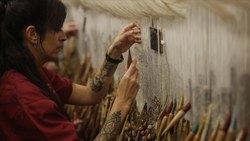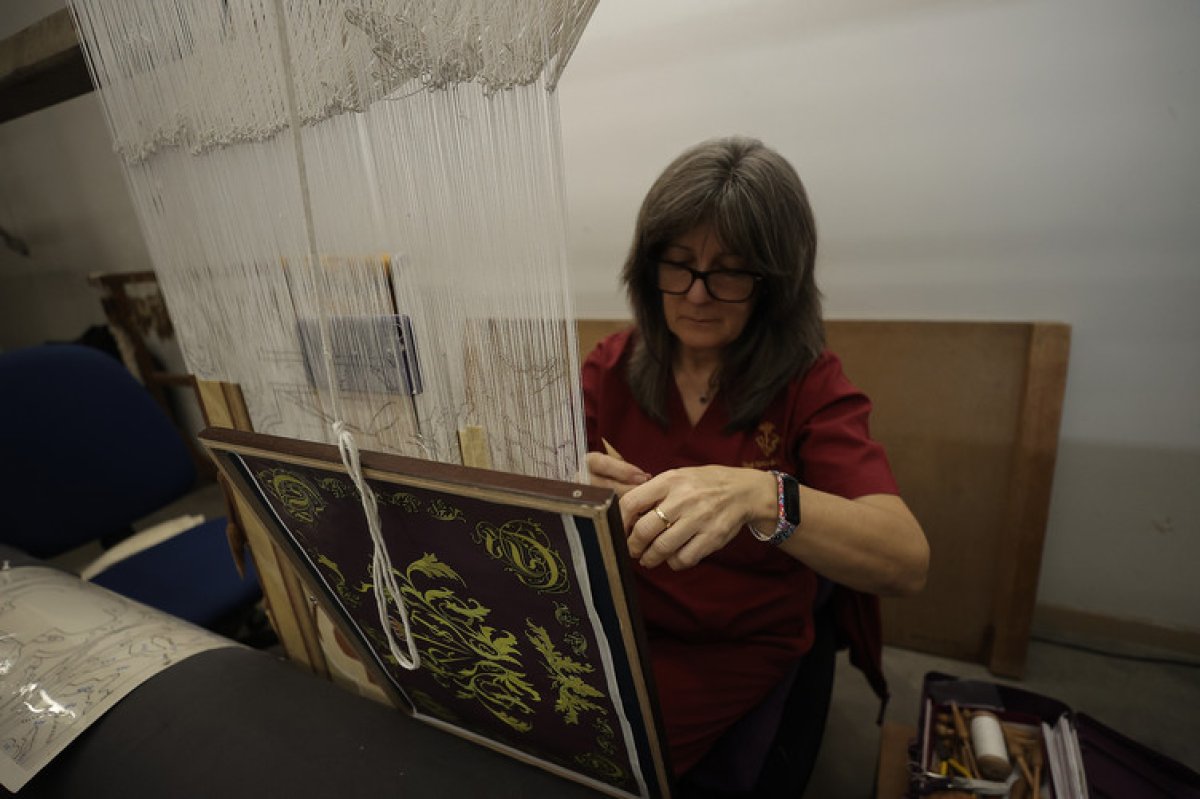The Spanish authorities utilized to UNESCO to incorporate the Spanish knot inherited from the Muslims on the “Intangible Cultural Heritage Listing”.

He discovered the carpet weaving method he discovered from the Muslims throughout the Andalusian Islamic interval (711-1492) within the Iberian Peninsula. “Spanish knot” Spain, which carries the title of this system to the current day, “Intangible Cultural Heritage Listing”utilized to the United Nations Instructional, Scientific and Cultural Group (UNESCO).
The Royal Carpet Weaving Manufacturing unit, which was established in Madrid, the capital of Spain, by the instruction of King Felipe V in 1721, stands out as the one carpet manufacturing heart that ensures the survival of the Spanish knot method inherited from the Muslims who dominated these lands for some time.
The Spanish knot, which differs from probably the most well-known and most utilized Turkish knot method in carpet weaving, because it can’t be utilized in curved drawings and is symmetrical on either side, is used solely in linen, silk and high quality wool yarn.
Within the zigzag patterned Spanish knot method, greater than 72,500 yarn knots are made per sq. meter, whereas it’s about twice as lengthy and dear to finish as a Turkish knot by way of time and value.
“Carpet weaving with the Spanish knot method began in Egypt and got here to the Iberian Peninsula throughout the Islamic interval of Andalusia”
Alejandro Klecker de Elizade, Common Director of the Royal Carpet Weaving Manufacturing unit in Madrid, one of many uncommon locations that makes use of Turkish knot and Spanish knot methods in carpet and rug weaving, mentioned in a press release to AA correspondent. “The Spanish knot has a historical past of greater than 2,300 years. Nevertheless, it was introduced from Egypt to the Iberian Peninsula throughout the Andalusian Islamic interval. Since many Muslim households continued this custom at the moment, they stayed on this area and later started to be known as the Spanish knot.” mentioned.

Major market Center East international locations
Klecker de Elizade defined that the Spanish knot, which was hardly used for a very long time because of the finish of the Muslim domination within the Iberian Peninsula in 1492 and the Catholic kings making an attempt to utterly erase the cultural historical past associated to Islam within the area, was tried to be stored alive with some initiatives began within the twentieth century. continued:
“Though there was an excessive amount of carpet manufacturing in Spain within the fifteenth and sixteenth centuries, these have been all the time made with Turkish knots. The Spanish knot could be very advanced and dearer. It was a method that was virtually in peril of disappearing within the seventeenth century. Within the twentieth century, particularly within the south, comparable to Cadiz, 2- Some weaving workshops have been established in 3 Spanish cities, however there was not a lot success in carpet manufacturing as a result of there was not a lot demand.”
Klecker de Elizade, who said that the industrial gross sales of carpets made with Spanish knots are very restricted attributable to their particular and costly nature, emphasised that their greatest benefit is the Center East market in the mean time.
In accordance with the information of AA, the director of the manufacturing facility, which can also be used as a museum, “Qatar, United Arab Emirates and Saudi Arabia are our precedence clients. These international locations see themselves as a part of this Spanish-Muslim heritage on the similar time. On the similar time, rich households from Colombia, Venezuela and Mexico have began to purchase carpets from us. Nevertheless, there are 12-14 weavers in our manufacturing facility. Even when we work on the highest effectivity, we are able to produce a most of 20 carpets per 12 months.” he mentioned.

“Palaces, Parliament and Senate buildings in Spain are stuffed with Turkish carpets”
Klecker de Elizade mentioned that Turkish knot and Turkish carpets are identified around the globe and that additionally they use Spanish and Turkish knotting methods collectively. “Everybody is aware of Turkish carpets as a result of most of the palaces in Spain, the buildings of the Parliament, the Senate, the Financial institution of Spain or the homes of Spanish noble households are adorned with Turkish carpets. Solely one among each 30 carpets we make is with Spanish knots.” used the phrases.
Klecker de Elizade famous that, because the Royal Carpet Weaving Manufacturing unit, there have been some initiatives for cooperation between Turkish and Spanish carpet weaving artists, comparable to restoration methods and drawing, via the Turkish Embassy in Madrid just a few years in the past, however they haven’t been capable of implement them but.
Stating that it will be very invaluable to research the historic adjustments in Turkish and Spanish carpet artwork, the Spanish Director mentioned, “It will likely be necessary to rediscover the intervals of carpet weaving, each Turkish and Spanish, and to search out widespread factors.” mentioned.
“Within the carpet weaving tradition, Spain is the inheritor of the Center East world in Turkey’s Ottoman historical past.” Klecker de Elizade mentioned that Spain received its turquoise blue coloration, which it loves a lot, from the Ottomans, and that silk and wool are utterly based mostly on Spanish-Muslim roots.
“There are only a few locations on the planet that do what we do”
Reminding that the Council of Ministers in Spain determined to use for the Spanish knot to be included within the UNESCO Intangible Cultural Heritage Listing, Klecker de Elizade mentioned that there was quite a lot of demand from totally different elements of the world concerning handicrafts to UNESCO, however that the Spanish knot will likely be included on this checklist after understanding its historic and cultural traits. He mentioned he hoped.
Jose Ignacio Garcia, who entered this manufacturing facility with a ardour for drawing and has been carpet weaving for 49 years, “There are only a few locations on the planet that do what we do. There isn’t any manufacturing facility like ours in Europe. As with many handicrafts, if this system will not be preserved, it dangers disappearing sooner or later. It must be included within the cultural heritage checklist as a Spanish knot to be protected.” made its evaluation.

